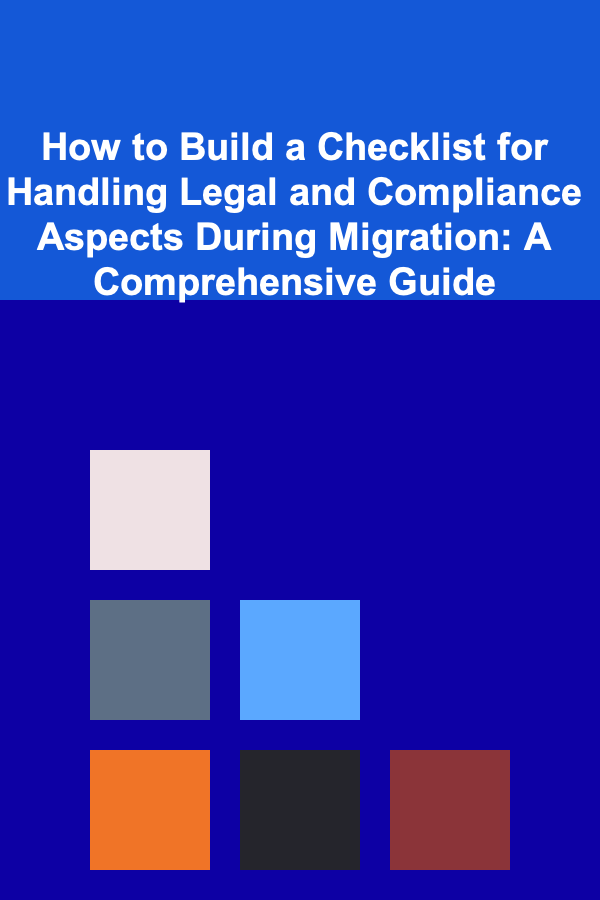
How to Build a Checklist for Handling Legal and Compliance Aspects During Migration: A Comprehensive Guide
ebook include PDF & Audio bundle (Micro Guide)
$12.99$5.99
Limited Time Offer! Order within the next:

Migrating data, systems, or entire business operations to a new environment---whether to the cloud, a new data center, or another geographical region---can be a highly complex process. While many organizations focus on technical and operational challenges, it is crucial not to overlook the legal and compliance aspects of migration. Failing to address these areas can lead to severe penalties, data breaches, and damage to reputation.
This guide provides actionable steps on how to build a checklist for handling the legal and compliance aspects of migration, ensuring that your migration process remains both efficient and compliant with applicable laws and regulations.
Understand the Legal and Compliance Landscape
The first step in building a checklist for handling the legal and compliance aspects of migration is to gain a clear understanding of the regulatory environment that governs your organization's operations.
Key Regulations to Consider:
- Data Privacy Laws: For businesses operating in multiple jurisdictions, it is essential to comply with local data protection laws, such as the General Data Protection Regulation (GDPR) in the EU, the California Consumer Privacy Act (CCPA) in the United States, or the Personal Data Protection Act (PDPA) in Singapore.
- Industry-Specific Regulations: Certain industries, such as healthcare, finance, and energy, are subject to specific regulations such as HIPAA (Health Insurance Portability and Accountability Act) for healthcare or the Sarbanes-Oxley Act for financial reporting.
- Cross-Border Data Transfers: If your migration involves transferring data across borders, you need to be aware of the legal requirements related to cross-border data flows. For instance, the GDPR imposes restrictions on transferring personal data outside of the European Union unless certain safeguards are in place.
Actionable Tips:
- Identify Relevant Regulations: Understand which laws and regulations apply to your organization based on your location, industry, and the nature of the data involved.
- Engage Legal Counsel: Consulting with legal professionals specializing in data privacy and compliance is essential to ensure that you have a solid grasp of applicable regulations.
Data Classification and Sensitivity Assessment
Before initiating the migration, conduct a thorough assessment of the data that will be moved. This step is crucial for understanding the risks involved and the legal requirements tied to the data.
Key Considerations:
- Sensitive Data: Identify any sensitive data, including personal data, financial records, intellectual property, or health information. This type of data is subject to stricter compliance requirements.
- Data Ownership and Access Rights: Determine who owns the data, who has access to it, and how it will be protected during the migration.
- Data Retention and Deletion Policies: Understand the data retention requirements for your business, and ensure that old or obsolete data is securely deleted when no longer needed.
Actionable Tips:
- Create a Data Inventory: List all the types of data that will be migrated, specifying whether they are classified as sensitive, and note any regulatory requirements tied to them.
- Conduct a Sensitivity Analysis: Evaluate how different types of data need to be handled during the migration to ensure that sensitive information is adequately protected.
Assess Third-Party Providers and Contracts
One of the most important aspects of migration is dealing with third-party providers, such as cloud service providers, hosting providers, or other external vendors. Legal and compliance risks often stem from how these third parties handle your data during the migration process.
Key Considerations:
- Service Level Agreements (SLAs): Review SLAs with third-party providers to ensure that they outline the security measures and compliance standards expected during the migration process.
- Data Protection and Confidentiality Clauses: Ensure that contracts with third parties include adequate data protection and confidentiality clauses to safeguard your organization's sensitive data.
- Third-Party Audits and Certifications: Ensure that your third-party vendors comply with relevant certifications such as ISO 27001 or SOC 2, which demonstrate their commitment to information security and compliance.
Actionable Tips:
- Review and Update Contracts: Before migrating, revisit any contracts with third-party vendors to make sure they cover the security and compliance requirements for the migration.
- Ensure Proper Due Diligence: Conduct due diligence on the third-party provider's ability to comply with applicable laws and regulations.
Data Security and Risk Management
Migration is an opportune time to assess the risks associated with data security. The process of moving data can expose organizations to potential data breaches, unauthorized access, or other risks that could lead to non-compliance.
Key Considerations:
- Encryption: Ensure that data is encrypted both in transit and at rest during migration. Encryption is a key measure for protecting sensitive information and ensuring compliance with data privacy laws.
- Access Controls: Implement strong access controls to limit who can access data during the migration. Use multi-factor authentication (MFA) and role-based access controls (RBAC) to reduce the risk of unauthorized access.
- Monitoring and Logging: Implement monitoring and logging tools to track any unauthorized access attempts or suspicious activities during the migration process.
Actionable Tips:
- Create a Security Plan: Develop a security strategy that includes encryption, access controls, and monitoring to ensure the safety and integrity of data during the migration.
- Regular Risk Assessments: Perform a risk assessment before, during, and after the migration to identify potential vulnerabilities.
Regulatory Notifications and Approvals
Depending on the type of migration, you may be required to notify or obtain approval from regulatory authorities. This is especially important when migrating personal data or operating in regulated industries.
Key Considerations:
- Data Breach Notification Requirements: If there is a data breach during the migration process, regulatory bodies may require you to notify affected individuals and report the incident within a certain timeframe.
- Data Transfer Notifications: For cross-border data transfers, you may need to notify regulators or obtain explicit consent from individuals whose data is being transferred, depending on the applicable regulations.
- Regulatory Filings: Some industries or regions require businesses to file for regulatory approval before migrating data, especially when it involves sensitive information.
Actionable Tips:
- Know When to Notify: Familiarize yourself with notification requirements related to data breaches, cross-border transfers, or regulatory approvals specific to your industry.
- Track Notifications: Keep a detailed log of all required notifications and approvals, ensuring compliance with timelines and procedures.
Audit and Documentation
Maintaining thorough documentation is critical throughout the migration process. It ensures that you can prove compliance with legal and regulatory requirements if needed.
Key Considerations:
- Audit Trail: Keep an audit trail of all actions taken during the migration, including who accessed the data, what changes were made, and when the migration occurred.
- Documentation for Compliance: Document the steps taken to ensure compliance with data privacy laws, security measures implemented, and any regulatory approvals obtained.
Actionable Tips:
- Maintain a Migration Log: Create a detailed migration log that records key activities and decisions made throughout the process.
- Prepare for Post-Migration Audits: Be ready for audits by keeping all relevant documents organized and accessible, especially for regulatory purposes.
Post-Migration Compliance Monitoring
After the migration is complete, it's important to continue monitoring compliance to ensure that any new systems or processes remain in line with legal and regulatory requirements.
Key Considerations:
- Ongoing Data Protection: Ensure that your post-migration systems continue to follow best practices for data protection, including encryption, access controls, and security monitoring.
- Regulatory Compliance Checks: Regularly assess whether your organization is still in compliance with relevant laws and regulations, particularly as new laws or amendments may come into effect.
Actionable Tips:
- Continuous Monitoring: Implement continuous monitoring tools to ensure that data and systems remain secure and compliant post-migration.
- Conduct Regular Compliance Audits: Schedule regular internal or external audits to verify that compliance standards are being met.
Conclusion
Building a comprehensive checklist for handling the legal and compliance aspects of migration is essential to ensuring that your migration process is both efficient and legally sound. By understanding the regulatory landscape, classifying and assessing data sensitivity, engaging third-party vendors carefully, and implementing robust security and monitoring measures, you can avoid costly compliance errors and minimize risks during the migration process.
Ultimately, a proactive approach---supported by legal expertise, security planning, and ongoing monitoring---will ensure a smooth migration that meets legal and compliance requirements and positions your organization for success in the new environment.
Reading More From Our Other Websites
- [Home Budget Decorating 101] How to Transform Thrift Store Finds into Stunning Home Decor
- [Home Cleaning 101] How to Declutter and Clean Your Home in One Weekend
- [Small Business 101] How to Choose the Right Business Line of Credit for Your Startup
- [Home Lighting 101] How to Use Lighting to Create an Inviting Atmosphere for Guests
- [Personal Finance Management 101] How to Budget Personal Finance as a College Student
- [Home Pet Care 101] How to Choose the Right Harness or Collar for Your Dog
- [Home Party Planning 101] How to Create a Cozy Outdoor Space for Evening Events
- [Organization Tip 101] How to Organize Utensils for Batch Cooking
- [Home Cleaning 101] How to Clean a Fan and Keep It Running Smoothly
- [Home Budget Decorating 101] How to Build DIY Room Dividers: Create Zones & Privacy Without Breaking the Bank

How to Create Attractive Listings for Used Books on eBay
Read More
How to Use Baskets for Small Music Accessories
Read More
How to Understand Marker-Based Augmented Reality
Read More
How to Find Fitness Communities Abroad
Read More
How To Apply Absurdism to Embrace Life
Read More
Finding Serenity in the Deserts of Jordan
Read MoreOther Products

How to Create Attractive Listings for Used Books on eBay
Read More
How to Use Baskets for Small Music Accessories
Read More
How to Understand Marker-Based Augmented Reality
Read More
How to Find Fitness Communities Abroad
Read More
How To Apply Absurdism to Embrace Life
Read More